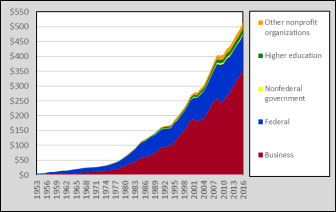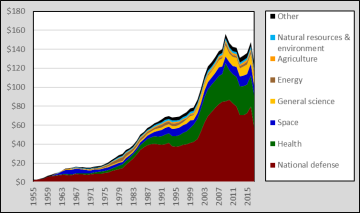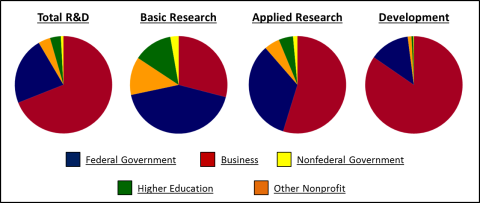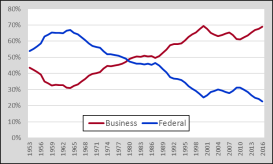U.S. Research and Development Funding and Performance: Fact Sheet
Changes from September 19, 2019 to January 24, 2020
This page shows textual changes in the document between the two versions indicated in the dates above. Textual matter removed in the later version is indicated with red strikethrough and textual matter added in the later version is indicated with blue.
U.S. Research and Development Funding and Performance: Fact Sheet
Research and development (R&D) in the United States is funded and performed by a number of sectors—including the federal government, state governments, businesses, academia, and nonprofit organizations—for a variety of purposes. This fact sheet begins by providing a profile of the U.S. R&D enterprise, including historical trends and current funding by sector and by whether the R&D is basic research, applied research, or development. The final section of this fact sheet includes data on R&D performance by sector.
Historical Trends in U.S. R&D Funding
The United States became a global leader in R&D in the 20th century, funding as much as 69% of annual global R&D in the period following World War II.1 Figure 1 shows the growth in total U.S. R&D expenditures from 1953 to 20162018 in current dollars.2 U.S. R&D in 20162018 was 100112 times higher than it was in 1953 in current dollars, and 14more than 15 times higher in constant dollars.3 By sector, business-funded R&D grew the most during this period. However, faster growth in total R&D spending of other nations reduced the U.S. share of global R&D to approximately 2827.7% in 20162017.4
|
Figure 1. U.S. R&D Expenditures by Source of Funding, 1953- Current dollars, in billions |
 |
|
Source: CRS analysis of National Science Foundation, National Patterns of R&D Resources: 201 Notes: |
Two sectors—business and the federal government—have together accounted for more than 90% of U.S. R&D funding since 1953, though their combined share has fallen from a high of 98% in 1956 to 9192% in 2016. Federal R&D expenditures as a share of total U.S. R&D expenditures peaked in 1964 at 66.8%, the same year that business R&D expenditures reached a nadir of 30.8%. Between 1964 and 2000, the federal government's share fell and business's share rose. In 2000, business accounted for 69.4% of U.S. R&D expenditures and the federal government 25.1%. This shift in the composition of R&D funding resulted not from a reduction in federal government R&D expenditures, but rather from faster growth in business R&D expenditures. From 2000 to 2010, business R&D's share declined from 69.4% to 6061.0%, and has risen each year since, reaching an all-time high of 69.769.0% in 20162018; from 2010 to 20162018, the federal share has declined from 31.1% to 22.521.9%.5 (See Figure 2.)
Trends in Federally Funded R&D
Trends in Federally Funded R&D
In current dollars, federal funding for R&D grew from $2.8 billion in 1953 to $116.1127.2 billion in 20162018, a compound annual growth rate (CAGR) of 6.1%. In constant dollars, federal R&D grew by a 2.8% CAGR during this period. However between 2011 and 2014, federal R&D funding, as measured in current dollars, fell for three consecutive years for the first time since such data has been collected; the total decline in federal funding for these years was $8.7 billion (6.8%). In constant dollars, federal R&D has declined seven straight years, from 2009 to 2016., by a total of $22.8 billion (17.2%)16.8%; a similar drop occurred from 1987 to 1994, when federal R&D fell by 16.0%.6
Figure 3 shows federal R&D funding by budget function in constant dollars from 1953 to 20151955 to 2019.
|
Figure 3. Federal R&D Funding by Budget Function, 1955- Current dollars, in billions |
 |
|
Source: CRS analysis of data from National Science Foundation, Federal R&D Funding, by Budget Function: Fiscal Years
|
Trends in U.S. Business-Funded R&D
Business funding of R&D, measured in current dollars, has grown nearly every year since 1953. In current dollars, business-funded R&D grew from $2.2 billion in 1953 to $355.5404.2 billion in 20162018, a compound annual growth rate (CAGR) of 8.43%. In constant dollars, business-funded R&D grew by a 5.0% CAGR during this period. In recent years, business-funded R&D has grown at a slower pace. Between 2000 and 20162018, business R&D grew by a 4.14% CAGR in current dollars, and by a 2.24% CAGR in constant dollars.7
Current Composition of U.S. R&D Funding
|
Character of R&D: Definitions Basic research. Experimental or theoretical work undertaken primarily to acquire new knowledge of the underlying foundations of phenomena and observable facts, without any particular application or use in view. Applied research. Original investigation undertaken to acquire new knowledge; directed primarily, however, toward a specific, practical aim or objective. Development. Systematic work, drawing on knowledge gained from research and practical experience and producing additional knowledge, which is directed to producing new products or processes or to improving existing products or processes
|
R&D funding can be categorized by the character of the work that it supports: basic research, applied research, and development. (See text box for definitions.) Total estimated U.S. R&D expenditures in 20162018 (the most recent year for which data are available) were $515.3580.0 billion. Of this amount, $88.696.5 billion (17.216.6%) was for basic research, $104.6115.0 billion (20.319.8%) was for applied research, and $322.1368.5 billion (6263.5%) was for development.8
Table 1 shows total U.S. R&D expenditures in 20162018 by funding sector and character of work. Notably, federal R&D funding accounts for the largest share of basic research (42.641.8%) while industry accounts for the largest shares of applied research (54.83%) and development (69.085.2%). Figure 4 shows this information graphically.
|
Sector |
Basic Research |
Applied Research |
Development |
Total |
||||
|
Dollars |
Percent |
Dollars |
Percent |
Dollars |
Percent |
Dollars |
Percent |
|
|
Federal Government |
$37.8 |
42.6 |
$35.4 |
33.9 |
$42.9 |
13.3 |
$116.1 |
22.5 |
|
Nonfederal Government |
2. |
2. |
1. |
1. |
0.6 |
0.2 |
4. |
0. |
|
Business |
25.7 |
29.0 |
57.3 |
54. |
272.5 |
84.6 |
355.5 |
69. |
|
Higher Education |
11.5 |
12.9 |
5. |
4. |
2. |
0.6 |
18.5 |
3.6 |
|
Other Nonprofit Organizations |
11.2 |
12.6 |
5. |
5.1 |
4. |
1. |
20.6 |
4.0 |
|
Total |
$88.6 |
100.0 |
$104.6 |
100.0 |
$322.1 |
100.0 |
$515.3 |
100.0 |
Source: CRS analysis of National Science Foundation, National Patterns of R&D Resources: 2016–17 Data Update, February 27, 2019.
Note: Rows and columns may not add to totals due to rounding.
| 2018 |
 |
|
Source: CRS analysis of |
Current Composition of U.S. R&D Performance
R&D is often performed by sectors other than the one funding the R&D. For example, the federal government performs some of the research it funds, but also funds research performed by business, universities and colleges, and other organizations. Table 2 provides data on performance of U.S. R&D by sector and character of the work (basic research, applied research, and development).
|
Sector |
Basic |
Applied Research |
Development |
Total |
||||
|
Dollars |
Percent |
Dollars |
Percent |
Dollars |
Percent |
Dollars |
Percent |
|
|
Federal Government |
$10.3 |
11. |
$17.4 |
16.6 |
$23.4 |
7.3 |
$51.1 |
9.9 |
|
Nonfederal Government |
0.1 |
0.1 |
0.5 |
0. |
0.0 |
0.0 |
0. |
0.1 |
|
Business |
24.6 |
27. |
61.0 |
58.3 |
289.0 |
89. |
374.7 |
72. |
|
Higher Education |
42.3 |
47.7 |
19.1 |
18. |
6.5 |
2.0 |
67.8 |
13.2 |
|
Other Nonprofit Organizations |
11.2 |
12. |
6.6 |
6.3 |
3. |
1.0 |
21.0 |
4. |
|
Total |
$88.6 |
100.0 |
$104.6 |
100.0 |
$322.1 |
100.0 |
$515.3 |
100.0 |
Source: CRS analysis of National Science Foundation, National Patterns of R&D Resources: 2016–17 Data Update, February 27, 20192017–18 Data Update, NSF 20-307, Tables 2-5, January 8, 2020.
Note: Rows and columns may not add to totals due to rounding.
Data for 2018 data are preliminary and may be revised.Author Contact Information
Footnotes
| 1. |
Office of Technology Policy, U.S. Department of Commerce, The Global Context for U.S. Technology Policy, 1997. |
| 2. |
Data for all years in this report are for calendar years unless otherwise specified. |
| 3. |
|
| 4. |
Organisation for Economic Co-operation and Development, OECD.Stat, Main Science and Technology Indicators, database, https://stats.oecd.org/Index.aspx?DataSetCode=MSTI_PUB. 2017 is the latest year for which complete data is available. For more information about global R&D, see CRS Report R44283, Global Research and Development Expenditures: Fact Sheet, by John F. Sargent Jr. |
| 5. |
CRS analysis of |
| 6. |
Ibid. |
| 7. |
Ibid. |
| 8. |
Ibid. Elements do not add to 100% due to rounding. |
